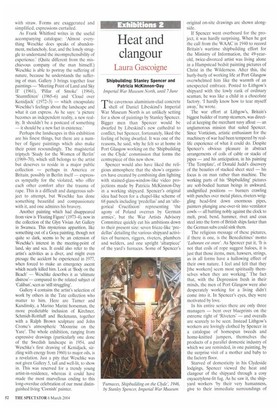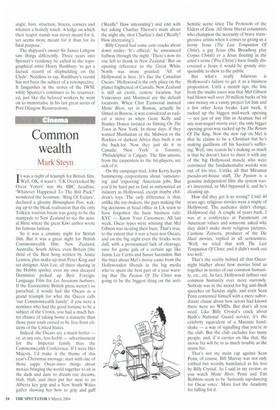Heat and clangour
Laura Gascoigne
Shipbuilding: Stanley Spencer and Patricia McKinnon-Day Imperial War Museum North, until 7 June
The cavernous aluminium-clad concrete shell of Daniel Libeskind's Imperial War Museum North is an unlikely setting for a show of paintings by Stanley Spencer. Bigger men than Spencer would be dwarfed by Libeskind's new cathedral to conflict, but Spencer, fortunately, liked the feeling of being dwarfed. It was one of the reasons, he said, why he felt so at home in Port Glasgow working on the 'Shipbuilding on the Clyde' commission that forms the centrepiece of this new show.
Spencer would also have liked the religious atmosphere that the show's organisers have created by combining dim lighting with stained-glass-window-like video projections made by Patricia McKinnon-Day in a working shipyard. Spencer's original idea had been for a chapel-like scheme of 68 panels including `predellas' and an 'allegorical Crucifixion' representing 'the agony of Poland overrun by German armies', but the War Artists Advisory Committee quickly cut his ambitions down to their present size: seven frieze-like 'predellas' detailing the various shipyard activities of burners, riggers, riveters, plumbers and welders, and one upright 'altarpiece' of the yard's furnaces. Some of Spencer's original on-site drawings are shown alongside.
If Spencer went overboard for the project, it was hardly surprising. When he got the call from the WAAC in 1940 to record Britain's wartime shipbuilding effort for the Ministry of Information, the 49-yearold, twice-divorced artist was living alone in a Hampstead bedsit painting pictures of Christ in the Wilderness. After this, the hurly-burly of working life at Port Glasgow overwhelmed him like the warmth of an unexpected embrace. Posted to Lithgow's shipyard with the lowly rank of ordinary seaman, he was like a child in a chocolate factory. 'I hardly know how to tear myself away,' he wrote.
The war effort at Lithgow's, Britain's biggest builder of tramp steamers, was directed at keeping the merchant navy afloat — an unglamorous mission that suited Spencer. Since Vorticism, artistic enthusiasm for the machinery of war had been tempered by reallife experience of what it could do. Despite Spencer's obvious pleasure in abstract arrangements of coils of cable or stacks of pipes — and his anticipation, in his painting 'The Template', of Donald Judd's discovery of the beauties of stacked sheet steel — his focus is on man rather than machine. The working parts of his 'Shipbuilding' pictures are soft-bodied human beings in awkward, undignified positions — burners crawling with punches over metal plates, riveters wriggling head-first down enormous pipes, painters plunging arse-over-tit into ventilator cowls — all battling nobly against the clock to melt, prod, bend, hammer, rivet and coax steel into the form of British ships faster than the German subs could sink them.
The religious message of these pictures, if there is one, is the Benedictines' motto Laborare est orare'. As Spencer put it, 'It is not that coils of rope suggest haloes, it is just that those items, men, hawsers, strings, as in all forms have a hallowing effect of their own nature. [feel and felt that they [the workers] seem most spiritually themselves when they are working.' The fact that, with the Depression fresh in their minds, the men of Port Glasgow were also desperately working for a living didn't come into it. In Spencer's eyes, they were motivated by love.
In his entire series there are only three managers — bent over blueprints on the extreme right of 'Riveters' — and overalls are scarcely to be seen. Instead Lithgow's workers are lovingly clothed by Spencer in a catalogue of homespun tweeds and home-knitted jumpers, themselves the products of a parallel domestic industry of which we are reminded, in one painting, by the surprise visit of a mother and baby to the factory floor.
Starved of domesticity in his Clydeside lodgings, Spencer viewed the heat and clangour of the shipyard through a cosy oxyacetylene-lit fug. As he saw it, the shipyard workers 'by their very humanness, give to their immediate surroundings of angle, bars, structure, braces, corners and whatnot a homely touch. A ledge on which their teapot stands was never meant for it, yet seems more meant for it than for its final purpose.'
The shipyard's owner Sir James Lithgow saw things differently. Three years into Spencer's residency he called in the topographical artist Henry Rushbuty 'to get a factual record of shipbuilding on the Clyde'. Needless to say, Rushbury's record has not been the subject of a retrospective. It languishes in the stores of the IWM, while Spencer's continues to be resurrected, just like the beloved workers he went on to immortalise in his last great series of Port Glasgow Resurrections.



















































































 Previous page
Previous page